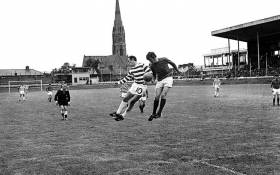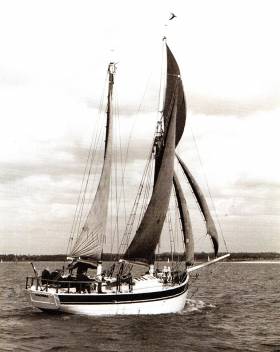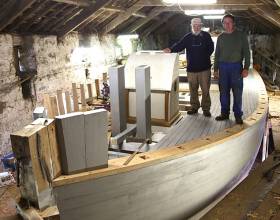Displaying items by tag: Conor O’Brien
Ireland’s Conor O’Brien Circumnavigation Centenary Celebrations Feel Like Fantasy Fulfilled
Let us imagine that you are both an enthusiast for Conor O’Brien (1880-1952), the Shannon Estuary’s great pioneering voyager, and that you are also one of those number-crunchers who enjoy calculating on what particular day significant anniversaries will fall in the future. Let us also imagine that it is twenty-five years ago, and you happen to be a regular reader of the Sailing on Saturday column, which in those pre-internet days always appeared – summer and winter - in our largest-circulation daily newspaper, The Irish Independent.
Let us further imagine (we’re really stretching this) that all those years ago, you’re idly considering what days fall when - in 2023 - the Centenary of the beginning of Conor O’Brien’s great voyage with the Baltimore-built 42ft ketch Saoirse round the world south of the Great Capes occurs. And lo, when you note that the 1st April 2023 falls on a Saturday, won’t you inevitably think that it would make for a grand idea, 25 years in the future, to use April Fool’s Day 2023 to make a spoof reveal in Sailing on Saturday that not only has Saoirse herself been painstakingly re-created in secret, but somehow – also in secret – the 56ft Conor O’Brien Falkland Islands ketch Ilen has been immaculately restored, and both will be sailing Ireland’s seas and further afield in 2023 in proper celebration of O’Brien’s achievement.
 Fantasy becomes reality – the restored Ilen during a cruise to Greenland in 2019. Photo: Gary Mac Mahon
Fantasy becomes reality – the restored Ilen during a cruise to Greenland in 2019. Photo: Gary Mac Mahon
Back then, it would have seemed a very useful notion to put in the Totally Crazy Ideas Store-Room, for implementation in due course when 2023 came around. But now, it is 2023. However, our world is going through such a phase of sometimes tragic absurdity that the very idea of April Fool stories seems almost offensive. Yet if we take out that daft idea of 25 years ago, and hold it up to the light, we find that not only are the Ilen restoration and the Saoirse re-creation sailing the seas and looking very well indeed, but the Centenary is being celebrated in a seemly manner with restrained yet very appropriate ceremonies, while further honoured with the timely re-publication of O’Brien’s relevant books.
 The “new” Saoirse has her first sail, February 2023. Photo: Kevin O’Farrell
The “new” Saoirse has her first sail, February 2023. Photo: Kevin O’Farrell
GARY MAC MAHON’S UNRIVALLED INPUT
Let us be in no doubt that the very existence of Saoirse and Ilen in their present healthy form is due in the first instance to the dogged – sometimes maddeningly so – determination and almost blind faith of Gary Mac Mahon of Limerick. Twenty-five years ago, he had recently inspired the return to Ireland from the Falkland Islands of the decommissioned but still very much alive 56ft 1926-built trading ketch Ilen. Subsequently, he went out to Jamaica, where the 1922-built 42ft Saoirse had come ashore in 1979 on a beach in the aftermath of hurricane, and bought up every last bit of the ship that could still be found.
And then – for she had never been declared a total wreck – he bought these bits and pieces from the then owner, and became the registered owner of what we now probably have to think of as the “first Saoirse”.
But even while this was all going on, Gary was still very much involved in the restoration of Ilen at Liam Hegarty’s boatyard at Oldcourt above Baltimore in concert with the Ilen Project Boatbuilding School in Limerick, and deeply immersed – sometimes to the point of semi-drowning - with the endless fund-raising involved in providing the resources required to make her into a certified educational sailing vessel.
 Gary Mac Mahon at the helm of Ilen in Greenland, July 2019
Gary Mac Mahon at the helm of Ilen in Greenland, July 2019
Yet with all this taking place, he still had to find the time to think about placing advance orders for the timber which would be required to build the “old-new” Saoirse once the Ilen restoration project had been completed. While he enjoyed the backroom research aspects of it all, and the practical experience of seeing the ships taking shape, as a very private person who definitely marches to the beat of a different drum, he found the necessary public appearances utterly exhausting and emotionally draining, such that the support of his wife Michelle and colleagues in their shared design venture, the Copper Reed Studio in Limerick, was invaluable.
CONOR O’BRIEN CENTENARY AQUIRES OWN MOMENTUM
But now, with the entire Conor O’Brien Centenary project acquiring an unstoppable momentum of its own, after 27 years, Gary Mac Mahon is in the process of stepping back from frontline involvement. We use the term “in the process” advisedly, for with such a complex individual implementing this extraordinary range of ideas, straightforward boundaries are difficult to delineate.
Nevertheless, Ilen is now into the complete management of the Sailing Into Wellness movement, while the building, commissioning and sailing of Saoirse has long since been the private venture of Fred Kinmonth, a Hong Kong-based corporate lawyer with an already distinguished sailing career, and a longterm family connection to West Cork.
 Baltimore Wooden Boat Festival, with Kevin O’Farrell’s Mylne-designed classic Canna on left
Baltimore Wooden Boat Festival, with Kevin O’Farrell’s Mylne-designed classic Canna on left
In fact, West Cork is now the focus of attention, and just this week the noted West Cork-based photographer Kevin O’Farrell (himself the owner of the very special Alfred Mylne Scottish Islands Classic OD Canna) has released an unprecedented photo of Saoirse and Ilen in line ahead together on the slipway at Liam Hegarty’s yard, with their first conspicuous date afloat being the Baltimore Wooden Boat Festival in the final weekend of May 2023.
ARTWORK AND BOOKS
Kevin O’Farrell has already published an extremely evocative book of atmospheric photos of Ilen being restored, and soon a similar book about the Saoirse will appear. Meanwhile, painters and illustrators have inevitably been drawn to the unique atmosphere which prevails in the old Top Shed at Oldcourt when the work is under way, and our headline image has been provided by Baltimore-based artist Paula Marten, who will be having an exhibition of her work during the Baltimore Wooden Boats.
 Vincent Murphy’s re-print of Conor O’Brien’s From Three Yachts utilises “Primitive School” paintings of the three vessels with which O’Brien was most closely associated
Vincent Murphy’s re-print of Conor O’Brien’s From Three Yachts utilises “Primitive School” paintings of the three vessels with which O’Brien was most closely associated
BALTIMORE WOODEN BOAT FESTIVAL 2023
The official dates for the Festival are 26th to 28th May, but Paula’s exhibition will be in Bushe’s Bar from 24th May onwards. Meanwhile there are – or were - books a-plenty which related to O’Brien, but Kinsale’s Vincent Murphy, another of those who have been drawn into the Saoirse Spell, has arranged for the re-publishing of O’Brien’s interesting post-circumnavigation work From Three Yachts, while the Irish Cruising Club – through the energies of Alex Blackwell of Clew Bay – has brought out a sixth edition, with a new context-setting introduction, of the book of the voyage, Across Three Oceans.
 Charlotte O’Brien Delamer launches the 6th Edition of Across Three Oceans with ICC Commodore David Beattie. Photo: Daria Blackwell
Charlotte O’Brien Delamer launches the 6th Edition of Across Three Oceans with ICC Commodore David Beattie. Photo: Daria Blackwell
This was formally launched last weekend at the ICC Annual Dinner in Sligo by Conor O’Brien’s great-niece Charlotte O’Brien Delamer, and it includes the original foreword by Claud Worth. His status as a cruising and voyaging guru of world significance during the 1920s was such that Bill Nutting of New York sought his support in 1922 before bringing the Cruising Club of America into existence, with last year’s Centenary of the remarkably successful and influential CCA a testimony to the soundness of its founder’s thinking in seeking Worth’s support.
 As there are no images of Saoirse at sea under her world-circumnavigating rig, the new 6th Edition of Across Three Oceans captures the essence of this unique vessel in the simplest possible way.
As there are no images of Saoirse at sea under her world-circumnavigating rig, the new 6th Edition of Across Three Oceans captures the essence of this unique vessel in the simplest possible way.
Thus although we have published Claud Worth’s thoughts on Saoirse’s voyage before in Afloat.ie, it is so elegantly put that it deserves repetition here:
“…anyone who knows anything of the sea, following the course of the vessel day by day on the chart, will realise the good seamanship, vigilance and endurance required to drive this little bluff-bowed vessel, with her foul uncoppered bottom, at speeds of 150 to 170 miles a day, as well as the weight of wind and sea which must sometimes have been encountered…..
….. however common long ocean voyages in small yachts may become, Mr O’Brien will always be remembered for his voyage across the South Pacific and round the Horn.”
For those who prefer something more tangible, during June 2023, there will be a gathering of the Irish Cruising Club, the Royal Cruising Cub, the Ocean Cruising Club and Portuguese craft in Madeira to mark the exact Centenary there of Saoirse’s arrival after her maiden passage out from Dublin Bay, and naturally, there will be an initial get-together in Dun Laoghaire with Ilen then leading the way south.
And, of course, with June 20th 2025, so clearly being the Centenary of O’Brien’s return to Dunleary, as he preferred to call it, that will be the mother and father of all Centenary celebrations. But for those who think that’s still a very long time ahead, there’s one key date that surely deserves to be marked in some special way.
Some time towards or after midnight on the 2nd December 1924, Saoirse crossed the longitude of Cape Horn, having run down her easting from New Zealand in the Roaring Forties, and then veered south into the “Furious Fifties”. This little ketch built by Tom Moynihan and his team in Baltimore had secured her very special place in voyaging history. In the Irish time zone, it would already have been 3rd December 1924. Now there’s a neat Centenary celebration, set in a time of the year when celebrations come into their own.
 Twenty-five years ago, this would have been dismissed as mad fantasy –Saoirse and Ilen in line ahead this past week on the slipway at Oldcourt. Photo: Kevin O’Farrell
Twenty-five years ago, this would have been dismissed as mad fantasy –Saoirse and Ilen in line ahead this past week on the slipway at Oldcourt. Photo: Kevin O’Farrell
Kinsale Yacht Club member Vincent Murphy has put together a presentation on circumnavigator Conor O’Brien, which he will give on Thursday, February 9.
Murphy has compiled a booklet on the subject, which he is in the process of having printed at the moment for purchase on the night.
Conor O’Brien, a grandson of Young Irelander William Smith O'Brien, designed his own 42’ yacht, Saoirse, in 1922 and built it in a Baltimore boatyard. Then on 20th June 1923, he set out on a voyage around the world. He chose the most difficult route, the clipper route, west to east and south of Cape of Good Hope, Cape Leeuwin (SW Australia) and Cape Horn, the first small craft to do this.
After an eventful and groundbreaking voyage, he returned to Dún Laoghaire precisely two years later, on 20th June 1925. 10,000 people turned out to welcome him home.
Murphy's presentation will cover O'Brien's life in general, including his running guns for the Irish Volunteers in 1914 (both Conor and Erskine Childers were involved, Childers in Asgard and Conor in his earlier yacht, Kelpie) and, of course, his circumnavigation.
As Afloat reported earlier, Murphy travels to O'Brien's home on the Shannon Estuary before the KYC talk to deliver his presentation at Foynes Yacht Club tonight (Friday, January 13th).
The Journal has highlighted the upcoming centenary of Irish yachtsman Conor O’Brien’s pioneering circumnavigation.
In June 1923, Limerick man O’Brien set off on his yacht the Saoirse — named after the then newly created Irish Free State — on the two-year voyage that was to make him the first Irish amateur to sail around the world.
His indirect route across the southern oceans, following the winds, took him past the three great capes: South Africa’s Cape of Good Hope, Australia’s Cape Leeuwin and South America’s Cape Horn.
For many decades, however, O’Brien’s achievements were little more than a footnote in Irish history, due in part to his aristocratic background as the country forged a new identity post-independence.
But his legacy has been revived in more recent years, thanks to the traditional boat-building initiative in Limerick inspired by O’Brien’s Ilen — a similar vessel to the Saoirse that he had built in Baltimore for the Falkland Islands in 1926.
And what’s more, Saoirse herself re-emerged in 2018 in West Cork, where the 42ft ketch is proudly sailing once more.
The Journal has much more on the story HERE.
Barry Keane and Tony Doherty of Mountaineering Ireland have formally proposed that commemorative postage stamps be issued to celebrate the up-coming Centenary of Conor O’Brien’s pioneering voyage round the world south of the Great Capes with his Irish-built 42ft ketch Saoirse. Their involvement stems from the fact that it was a voyage which included a strong mountaineering element, a dynamic interaction of interests which Tony Doherty from Cork personally combined for many years with his 26ft sloop Bali Hai, even if now at the age of 76 he finds that his most enduring enthusiasm is for “being in the hills”.
One hundred years ago today, Conor O’Brien’s 42ft ketch Saoirse – to his own designs - was in process of construction by master shipwright Tom Moynihan and his team in Baltimore, West Cork. Before the 1922 season was out - and despite West Cork being one of the more active theatres of the Civil War - Saoirse was sailing, and the following year on June 20th 1923, she departed from the Royal Irish Yacht Club in Dun Laoghaire, ostensibly on a voyage to facilitate a mountaineering expedition in New Zealand.
 Conor O’Brien as sketched by his wife Kitty Clausen
Conor O’Brien as sketched by his wife Kitty Clausen
The then-extraordinary voyage which resulted is a familiar part of the long story of Irish sailing for those who are aware of our nautical history’s many aspects, which go back into the mists of time and further with the achievements of St Brendan the Navigator, and beyond that to the suggestion of maritime wonder and awareness in The Song of Amergin.
75TH ANNIVERSARY CELEBRATED IN 1998
But while Amergin and Brendan are big on mythology, the precisely two-years voyage of the Saoirse a hundred years ago between 1923 and 1925 is very real indeed, and in October 1998 there were celebrations and presentations in the Royal Irish Yacht Club to mark its 75th Anniversary.
Thus the O’Brien achievement is very much part of the bigger picture, with its significance fully recognised by those who realise just what a remarkable breakthrough it represented. And not just in its unrivalled place in global maritime history, but in the national story - it was the first major voyage made by a vessel flying the tricolour ensign of the new Irish Free State.
 For the 75th Anniversary of Saoirse’s voyage in 1998, this bust of Conor O’Brien – sculpted within the vertebrae of a blue whale by Danny Osborne - was presented by members of the Royal Cruising Club to the Royal Irish Yacht Club
For the 75th Anniversary of Saoirse’s voyage in 1998, this bust of Conor O’Brien – sculpted within the vertebrae of a blue whale by Danny Osborne - was presented by members of the Royal Cruising Club to the Royal Irish Yacht Club
This underlying awareness and enthusiasm for the unique nature of Conor O’Brien was already much in evidence in the Autumn of 1998, for a year earlier Gary MacMahon of Limerick – who made a significant input into the RIYC celebrations - had organised the return to Ireland from the Falkland Islands of the 1926 Baltimore-built 56ft trading ketch Ilen, which had been built to O’Brien’s designs, and which he’d sailed south to her lifetime of work among the Falkland Islands.
Ilen has since been superbly restored in a joint venture by boat-builder Liam Hegarty of Oldcourt near Baltimore with the Ilen Marine School of Limerick, and today she departs from Limerick with a fair wind for a 700-mile voyage to St Katherine Dock in the heart of London, where she’ll be based from May 1st to 7th for a series of cultural events to celebrate her own remarkable history and the ancient links between the two great river ports.
 The restored Ilen at her birthplace of Baltimore
The restored Ilen at her birthplace of Baltimore
NEW SAOIRSE UNDER CONSTRUCTION
Meanwhile, in Ilen’s former restoration berth in the top shed at Hegarty’s Boatyard, work has been in progress on a re-creation of Saoirse herself for noted Hong Kong offshore racing enthusiast Fred Kinmonth. It has been possible to do this with considerable precision, as the hull lines of the original were taken off by Uffa Fox in Cowes in 1927 before Conor O’Brien took part in that year’s Fastnet Race, and thus when the Saoirse replica sails again, she will be as authentic as possible.
 The new Saoirse at an early stage of construction in Oldcourt
The new Saoirse at an early stage of construction in Oldcourt
All these things are steadily taking shape as a reflection of the Conor O’Brien voyaging awareness in a significant group of longtime enthusiasts. Yet as is the way of things, every so often someone unacquainted with the broader picture and the historical context stumbles upon the Conor O’Brien story in isolation, and almost immediately announces that the “neglect” of O’Brien’s greatness is a national disgrace, and Something Must Be Done.
Thus there are at least three different Saoirse Voyage Centenary commemoration plans taking shape, and the laudable addition of the postage stamps possibility adds a further element to the festivities. Nevertheless, there are those who are extremely wary of anything that hints at re-enactments, as we sense that they cheapen the purity of the original magnificent achievement. But doubtless there will be acceptable re-enactments of various episodes, even if any attempt at a re-enactment of the complete original voyage would feel distinctly tacky.
 Straightforward celebration – the Irish nautical stamps of 1982 honoured (left to right), a currach, the Galway Hooker St Patrick, the Sail Training Brigantine Asgard II, and the Howth 17s of 1898 vintage
Straightforward celebration – the Irish nautical stamps of 1982 honoured (left to right), a currach, the Galway Hooker St Patrick, the Sail Training Brigantine Asgard II, and the Howth 17s of 1898 vintage
Be that as it may, the fact that people are yet again “discovering” the voyage of the Saoirse for the first time forcefully illustrates the notion that popular memory has to be reinforced with every new generation, in other words every 25 years or so, and thus a brief refresher on the basic story of the skipper of Saoirse seems to be required.
Conor O’Brien (1880-1972) was the scion of a landed family from the south shores of the Shannon Estuary, a family which had direct family links to the Earls of Inchiquin of Dromoland Castle, who in turn claimed descent from the medieval High King Brian Boru. O’Brien had long been an enthusiastic mountaineer and occasional inshore and inland waterways sailor before he added offshore voyaging to his interests in 1911.
 When the Tall Ships came to Dublin in 1998. An Post responded with this memorable stamp of Asgard II at full speed
When the Tall Ships came to Dublin in 1998. An Post responded with this memorable stamp of Asgard II at full speed
Though largely reared in England, Ireland was his spiritual home, and regular family holidays in Derrynane in Kerry strengthened his love of the sea and sailing, while he was already into mountaineering through youthful initiation in Snowdonia in Wales. He qualified as an architect and settled in Dublin, where he was one of the founders of the United Arts Club, and was drawn into the circle which included Erskine Childers and favoured Home Rule for Ireland.
THE HOWTH GUN-RUNNING
With his interest in seafaring increasing, he joined the Royal Naval Reserve in 1910 mainly to obtain formal training in navigation, and by 1911 he was cruising offshore – including in time a round Ireland venture – with the veteran ketch Kelpie. As the Gun-Running Scheme for the Irish Volunteers developed during 1914, O’Brien with Kelpie was detailed to collect the guns off the Belgian coast in company with Erskine & Molly Childers’ Asgard, and while it became known as the Howth Gun-Running thanks to Asgard’s successful discharge of her cargo at Howth on July 26th 1914, Kelpie’s cargo was subsequently successfully landed at Kilcoole in Wicklow after being transferred aboard the auxiliary yacht Chotah, owned and skippered by Sir Thomas Myles (RIYC).
 Conor O’Brien with his sister aboard Kelpie off Ireland’s West Coast in 1913
Conor O’Brien with his sister aboard Kelpie off Ireland’s West Coast in 1913
The Great War - World War I - broke out almost immediately, and many of the main actors in the gun-running played roles of varying distinction in the British forces, with Erskine Childers – an officer in the RNVR – somehow finding himself navigating the aircraft which made the first successful bombing raid into Germany. As for the more volatile Conor O’Brien, while his sometimes awkward personality provided an uneven history mostly mine-sweeping with the RNR for the duration, after war’s end in 1918 he had a sufficiently clear record with the RNR to subsequently stand him in good stead.
Meanwhile the Easter Rising of 1916 (using some of the Howth guns) led on to the Sinn Fein’s sweeping victory in the 1918 General Election, and the establishment of a provisional government in Dublin, an extraordinary parallel administration for which O’Brien worked as a Fisheries Inspector on the west coast, with his patrol vessel being the gallant old Kelpie.
 An unlikely Fisheries Inspector – Conor O’Brien aboard Kelpie. He preferred to sail and go mountaineering in his bare feet
An unlikely Fisheries Inspector – Conor O’Brien aboard Kelpie. He preferred to sail and go mountaineering in his bare feet
But while former sailing acquaintances such as Erskine Childers and Diarmuid Coffey became increasing involved with the developing situation of a War of Independence and then a Civil War over the Treaty agreed by the new Free State, O’Brien increasingly returned his attention to his other interests of sailing and mountaineering, and 1921 found him in Skye on the west coast of Scotland with Kelpie and some English friends, climbing extensively in the Cuillins.
Returning single-handed towards his then home port of Dun Laoghaire, he failed to be woken by an alarm clock as Kelpie went slowly to windward south through the North Channel, and the old boat came gently but permanently ashore in the night on some rocks on the Galloway coast and started to break up. Conor O’Brien appeared out of the early morning mist in the harbour of Portpatrick, rowing Kelpie’s dinghy and surrounded by all his worldly goods.
Eventually, he got back to one of his family’s places on Foynes Island in the Shannon Estuary, and there in the final months of 1921 he developed the plans for Saoirse. The political and guerilla warfare situation was restless, to say the least, and yet by 1922 Saoirse was under construction with Tom Moynihan and his boat-building team in the Fisheries School – now an establishment of very mixed memories - in Baltimore.
 Conor O’Brien’s drawings for the homely accommodation of Saoirse – unlike most yachts of the time, he insisted on having the galley well aft in a position of seagoing comfort
Conor O’Brien’s drawings for the homely accommodation of Saoirse – unlike most yachts of the time, he insisted on having the galley well aft in a position of seagoing comfort
By the late Spring of 1923, Saoirse was ready, and though she officially departed for New Zealand from Dun Laoghaire on June 20th, as far as O’Brien was concerned her voyage had already started – as did all his major ventures – from his beloved Foynes.
Yet although some mountaineering did take place in New Zealand, it was known that ultimately O’Brien hoped to continue to run down his easting in the big winds and enormous seas of the Great Southern Ocean, and return to Ireland via Cape Horn, thereby becoming the first small boat to circumnavigate the world south of the Great Capes.
ROUNDING THE HORN
With Cape Horn safely astern on December 4th 1924, Saoirse made on for the Falklands, where she stayed for six weeks, and so impressed the locals that, in time, her larger sister the Ilen was commissioned by the Falkland Islands Company to be the inter-island freight and passenger service vessel.
But in 1925, Saoirse returned to Dun Laoghaire on June 20th, two years to the minute – or so some claimed – after her departure. She had been through something like 18 different crewmembers, as O’Brien was not the easiest of skippers. But all was now conviviality, and it being a Saturday, Dublin Bay Sailing Club cancelled their day’s racing in order that their fleet could properly provide a welcome home for Conor O’Brien and his remarkable little ship.
Then there was a well-attended parade into Dublin, and a gala dinner at the United Arts Club. But subsequently, while he had plans for a book of the voyage, events conspired to delay it as the contract for the Ilen had been signed, and work was soon under way back in Baltimore, with the new Ilen departing on 31st August 1926 for the long voyage to the Falklands under O’Brien’s command. She sailed as a yacht of the Royal Irish YC, as he had been unable to get insurance as a commercial skipper.
That mission accomplished, work could finally get properly under way on finishing “Across Three Oceans”, Conor O’Brien’s very readable if sometimes decidedly quirky account of Saoirse’s circumnavigation, which was soon published in 1927 to become something of a best-seller while he became - for a time - a celebrity.
But then, although he manifested a disdainful attitude to the trappings of celebrity, he had known how to put its foundations in place. Thus at the time of his voyage, the world “governing authority” on amateur cruising was the 1880-founded Royal Cruising Club. So in 1919, despite the developing ambiguities of his position in working with the Provisional Government, he had persuaded a former RNR shipmate Frank Gilliland of Derry, and his former gun-running colleague Erskine Childers, to support his successful election as an RCC member.
 Conor O’Brien in relaxed mood at the hem as Saoirse makes impressive yet comfortable knots far at sea
Conor O’Brien in relaxed mood at the hem as Saoirse makes impressive yet comfortable knots far at sea
In an unnerving illustration of the complexities of Irish life in that period, by the time Saoirse departed on her great voyage from Dun Laoghaire on June 20th 1923, Commander Frank Gilliland RN was in process of becoming Aide de Camp to the first Governor of the recently-established Northern Ireland. But Erskine Childers was dead, executed on November 24th 1922 by the new Free State government for his determinedly anti-treaty stance, and specifically for being illegally armed - when captured, he was carrying a tiny pistol once given to him for personal protection by Michael Collins at a time when they were allies.
In the confusion of the time, it may seem a miracle that Saoirse got away at all, but the ability of normal life to go on in Ireland in the early 1920s, despite wars and troubles, was remarkable. Thus as the voyage unfolded, O’Brien regularly submitted annual logs for what was then the world’s supreme voyaging trophy, the RCC Challenge Cup, and with Claud Worth the globally-recognised cruising guru adjudicating each time, he was awarded the Challenge Cup - three years on the trot - in 1923, ’24 and ’25.
O’BRIEN’S PLACE IN SAILING’S HALL OF FAME
This established O’Brien’s little place in sailing’s Hall of Fame, for of course it is the razzmatazz of racing – to which he was virtually a complete stranger – which sets the highlights in much sailing history.
 Saoirse was quite the proper little ship – in lighter winds, she could set stunsails
Saoirse was quite the proper little ship – in lighter winds, she could set stunsails
But now with the Saoirse Centenary approaching, we’ll find all sorts of searchlights focused on his achievement, for of course we know that Joshua Slocum was first to circumnavigate in 1895-1898, and single-handed too. But he did it largely in more temperate zones, whereas O’Brien’s voyage had the raw simplicity of the Roaring Forties, and a straightforward passing clear south of Cape Horn.
Thus with recent Irish Centenaries inevitably involving historic violence, it will be a welcome change for the Centenary of something so fresh and free from bloodshed to be celebrated, even if O’Brien himself was a former gun-runner. It may become complex with various groups having their own ideas as to how it should be done. But as the nautically-themed postage stamps with this piece reveal, it’s an attractve form of recognition with its own straightforward simplicity.
That said, the voyage of the Saoirse is of sufficient strength and beauty to stand on its own. In his foreword to Across Three Oceans, the quintessentially English Claud Worth set Conor O’Brien’s achievement in timeless perspective:
“Mr O’Brien’s plain seamanlike account is so modestly written that a casual reader might miss its full significance. But anyone who knows anything of the sea, following the course of the vessel day by day on the chart, will realise the good seamanship, vigilance and endurance required to drive this little bluff-bowed vessel, with her foul uncoppered bottom, at speeds from 150 to 170 miles a day, as well as the weight of wind and sea which must sometimes have been encountered…….however common long ocean voyages in small yachts may become, Mr O’Brien will always be remembered for his voyage across the South Pacific and round the Horn.”
Conor O’Brien Ketch Ilen Re-uses Old Gaelic Stadium Teak
The process of restoring the 1926-built 56ft Conor O’Brien ketch Ilen in Limerick and Baltimore has seen a countrywide network developing, a network in which anyone with access to redundant classic quality timber has been happy to see it finding a new use in the Ilen Boatbuilding School’s very special project writes W M Nixon.
Afloat.ie recently carried the story of how traditional rigging dead-eyes had been crafted from that rare timber lignum vitae, which in this case had been sourced from a former shipyard in Cork.
Now there has been a useful re-direction from nearer home, with teak which had provided slats for the seating in the old Markets Field Gaelic Stadium in Limerick for more than a century finding a new life as slats on the sole of the Ilen helmsman’s footwell.
 Less is more. A little bit of teak, tastefully installed as slats on the sole of Ilen’s beautifully-completed new footwell, sets the Antique White finish off to perfection. Photos: Gary MacMahon
Less is more. A little bit of teak, tastefully installed as slats on the sole of Ilen’s beautifully-completed new footwell, sets the Antique White finish off to perfection. Photos: Gary MacMahon
A hundred and more years ago, teak – the king of timbers - was much more readily available than it is today, and was sometimes used to excess. But modern boat-builders have learned that with the scarcity of this lovely wood, less can be more, and the way that the relatively small amount of teak has been usefully installed in the beautifully finished Ilen footwell certainly bears this out.
Having made a couple of journeys between the Ilen herself in Oldcourt near Baltimore and the boat-building school in Limerick, the elegant footwell will finally be fully installed on the ship within the next week.
Conor O’Brien’s World–Girdling Saoirse Will Sail Again
The process towards re-creating Conor O’Brien’s famous Baltimore–built 42ft ketch Saoirse, in which he gained his place in international sailing’s Hall of Fame with the first circuit of the world by a small vessel south of the great capes in 1923-1925, has been quietly confirmed this week with the agreement of a well-resourced backer who for the moment prefers to remain anonymous. W M Nixon takes a fresh perspective on one of Irish sailing’s central stories.
Much and all as there was triumph and tribulation and then triumph again in Conor O’Brien’s sailing achievements, his personal life could be summed up as one of success and sadness. So could many lives. But as with most things to do with Conor O’Brien, success and sadness came on an epic scale – there was a monumental, sometimes tragic quality to it.
It is something which is inevitably going to receive more attention as the process of re-creating his remarkable little ship swings into action in Oldcourt near Baltimore. The Saoirse re-build is coming centre stage in West Cork as the great and lengthy project of re-building his 57ft 1926 ketch Ilen nears completion. Ilen will be launched next summer, and the quality of the workmanship of Liam Hegarty and his craftsmen in Oldcourt with this project will achieve the recognition it so richly deserves.
So too will the vision of Gary MacMahon of the Ilen Boatbuilding School in Limerick who inspired Ilen’s re-birth, which in turn has provided the credentials to make the re-creation of Saoirse something which is becoming very real. It has become so real that the new keel has already been cut and shaped, while enough bits and pieces have been retrieved in Jamaica from the wreck of Saoirse in her first incarnation to provide a real connection for the re-born boat. Meanwhile, next week will see the orders being placed for further consignments of the required timber.
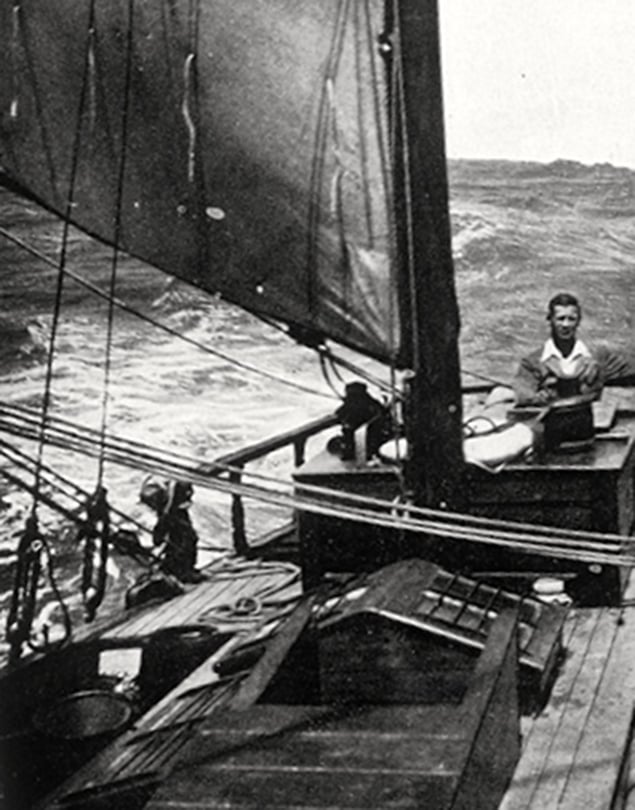 Conor O’Brien was at his most content when up in the mountains, or far out at sea. He is seen here at the helm of Saoirse in mid-ocean as she reels off the miles in her famous effortless style. Photo courtesy O’Brien family/Gary MacMahon
Conor O’Brien was at his most content when up in the mountains, or far out at sea. He is seen here at the helm of Saoirse in mid-ocean as she reels off the miles in her famous effortless style. Photo courtesy O’Brien family/Gary MacMahon
The very idea of some day being able to sail on an exact replica of Saoirse, a replica which has retained the soul of the original vessel, is something which will fascinate anyone who has made even the most cursory study of what O’Brien achieved on his voyage, and in his design of this unique boat.
There are probably many more in Ireland who are tangentially aware of O’Brien through the fact that, with the ketch Kelpie, which he owned from 1911 to 1922, he was the junior partner with Erskine & Molly Childers’ Asgard in the gun-running to Howth and Kilcoole in 1914, with Kelpie’s cargo of 600 Mauser rifles being taken for the final stage to the Kilcoole landing aboard Sir Thomas Myles’ auxiliary-powered Chotah. But in terms of the world’s amateur sailing history, the 1914 gun-running pales into insignificance when set against the mighty circumnavigation of the little Saoirse in 1923-25.
It was the first major international voyage undertaken under the ensign of the new Irish Free State. Yet despite the new tensions which inevitably existed between the British establishment – particularly the British maritime establishment - with the nascent Irish state and those who created it and ran it, it was a pillar of the British maritime establishment who set the international tone in putting Conor O’Brien’s voyage with Saoirse in its proper and revered context.
These days the name of Claud Worth will only be known to those who are immersed in the details of the history of cruising and its development. But in the first thirty years of the 20th Century, Claud Worth – ophthalmic surgeon by day, seagoing guru for much of the rest of the time – was an authority in a league of his own.
A kindly authority, let it be said. And always a source of helpful advice, with suggestions which are still relevant today. Just recently, someone asked about how best to prepare a log for a cruising competition. The most useful response was to quote Claud Worth’s suggestions from 1910 about how you should gradually introduce the boat, her crew and the planned cruise as the story unfolds, to bring the reader along with you to share the experience, rather than have it hurled at them as a mass of indigestible statistics about mileages, wind strengths, and dealing with problems large and small.
Thus by the time Saoirse set off on her voyage, Claud Worth was the global authority in the world of log adjudication, and he found himself in the demanding position of assessing logs for the world’s senior cruising trophy, the Challenge Cup of the Royal Cruising Club.
This had been awarded on its inauguration in 1896 to Belfast doctor, Howard Sinclair, for a cruise round Ireland in the 6-tonner Brenda. But by 1923, the scope of the several major cruises put forward for the Challenge Cup had expanded enormously from round Ireland voyages. Yet in his adjudications, Claud Worth unhesitatingly awarded the Challenge Cup for 1923, 1924 and 1925 to the former gun-runner as Saoirse’s voyage round the world went on to various ports, through the Great Southern Ocean, and back into Dun Laoghaire exactly two years to the day since he first departed on what had been casually described as “a voyage to New Zealand for some mountaineering”.
 Saoirse departs from Dun Laoghaire in June 1923 at the start of her voyage. Photo Irish Times In fact, so clearcut had Worth been in his analysis that he provided the Introduction for Conor O’Brien’s entertaining if sometimes eccentric account of Saoirse’s circumnavigation, the timeless sailing classic Across Three Oceans. Claud Worth’s foreword has so much insight that it continues today to be the final word on the voyage, and in a few pithy comments he sums up what had been achieved by the 42ft ketch to O’Brien’s own design, and built in fishing boat style by Tom Moynihan and his shipwrights in Baltimore.
Saoirse departs from Dun Laoghaire in June 1923 at the start of her voyage. Photo Irish Times In fact, so clearcut had Worth been in his analysis that he provided the Introduction for Conor O’Brien’s entertaining if sometimes eccentric account of Saoirse’s circumnavigation, the timeless sailing classic Across Three Oceans. Claud Worth’s foreword has so much insight that it continues today to be the final word on the voyage, and in a few pithy comments he sums up what had been achieved by the 42ft ketch to O’Brien’s own design, and built in fishing boat style by Tom Moynihan and his shipwrights in Baltimore.
“Mr O’Brien’s plain seamanlike account is so modestly written that a casual reader might miss its full significance” wrote Worth. “But anyone who knows anything of the sea, following the course of the vessel day by day on the chart, will realize the good seamanship, vigilance and endurance required to drive this little bluff-bowed vessel, with her foul uncoppered bottom, at speeds from 150 to 170 miles per day, as well as handling the weight of wind and sea which must sometimes have been encountered”.
The voyage completed, the energetic and sometimes impatient O’Brien was busy with fulfilling the contract he’d brought home with him to build the Ilen to be the Falkland Islands freight and passenger ketch, and with writing his book. Once the latter had appeared, his celebrity was assured, and he was persuaded to enter Saoirse in the 1927 Fastnet Race.
There was much windward work as soon as the fleet had left the Solent, and no-one in the crew disagreed when he eventually withdrew, as he’d re-rigged Saoirse as a sort of mini brigantine, and windward work definitely wasn’t her strong suit. But it had by no means been a wasted expedition, for in Cowes before the race, designer Uffa Fox took off Saoirse’s lines. O’Brien - an architect by training - may have designed her himself, but many of his drawings were distinctly free-form, so now that Saoirse is going to be re-created, the precision of Uffa Fox’s work is going to be invaluable in getting once again the exact shape of “this little bluff-bowed vessel”.
 Saoirse’s accommodation - Conor O’Brien’s personal drawings. Courtesy O’Brien family/Gary MacMahon
Saoirse’s accommodation - Conor O’Brien’s personal drawings. Courtesy O’Brien family/Gary MacMahon
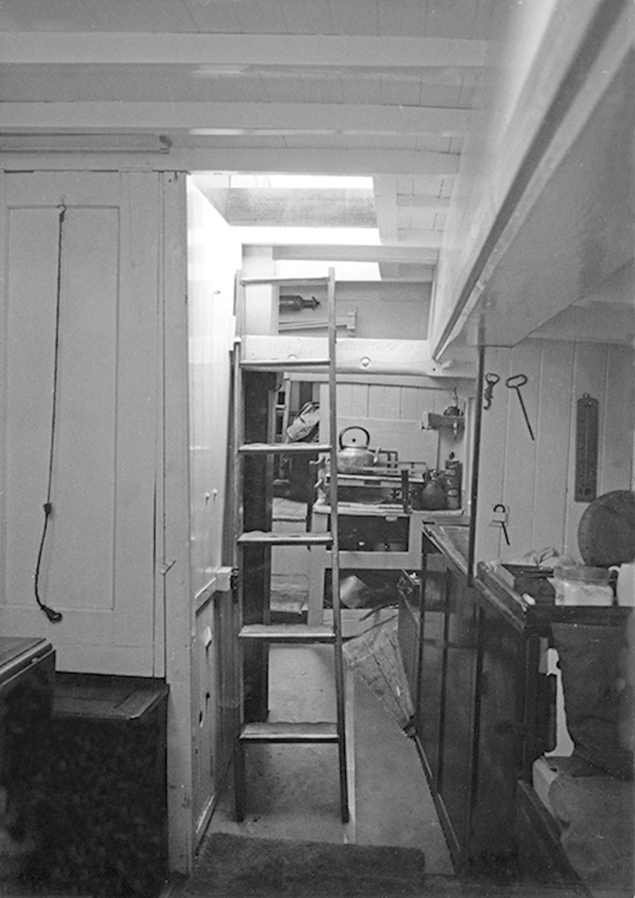 The homely comfort down below. Conor O’Brien may have used old-fashioned concepts in creating Saoirse, but he was well ahead of his time in placing the galley down aft in the position of least motion. Photo courtesy O’Brien family/Gary MacMahon
The homely comfort down below. Conor O’Brien may have used old-fashioned concepts in creating Saoirse, but he was well ahead of his time in placing the galley down aft in the position of least motion. Photo courtesy O’Brien family/Gary MacMahon
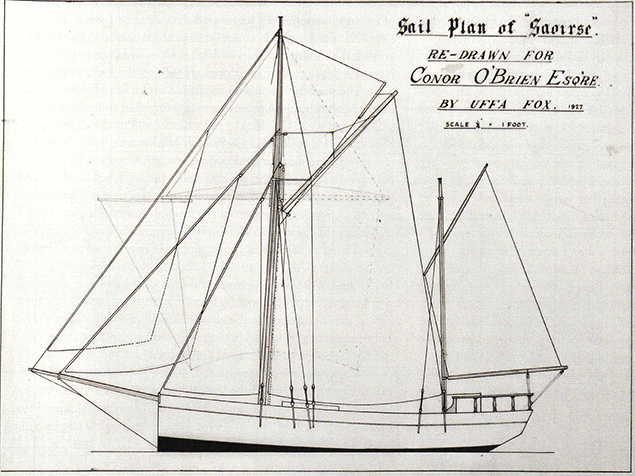 Saoirse’s hull and sailplan profile as recorded by Uffa Fox in 1927. Courtesy O’Brien family/Gary MacMahon
Saoirse’s hull and sailplan profile as recorded by Uffa Fox in 1927. Courtesy O’Brien family/Gary MacMahon
 Saoirse’s hull lines as taken off by Uffa Fox at Cowes in 1927 Courtesy O’Brien family/Gary MacMahon
Saoirse’s hull lines as taken off by Uffa Fox at Cowes in 1927 Courtesy O’Brien family/Gary MacMahon
As the 1920s drew to a close, Conor O’Brien was at something of a loose end. Of a land-owning family in West Limerick, his expected inherited income had shrunk with the effects of the various Land Acts which had started in the year of his birth, 1880. It was a situation of which a part of him approved, yet he could be such a prickly individual that he never functioned comfortably in the committee situations which his speciality as an ecclesiastical architect required him to work, and thus his earning levels could be precarious
He was uncompromising in his approach to anything and everything. Saoirse was a complete statement of his wish to have a simpler world in which every item was attractively functional. She was the seagoing expression of his enthusiasm for the purest tenets of William Morris’s Arts and Crafts movement. It will be intriguing, when she is reborn, to see if she really is as comfortable as it appears in the drawings and photos. These seem to suggest that she’s the sort of boat it’s a pleasure to be aboard for extended periods, and you will definitely be in her rather than on her - she is a a proper little ship, a world of her own.
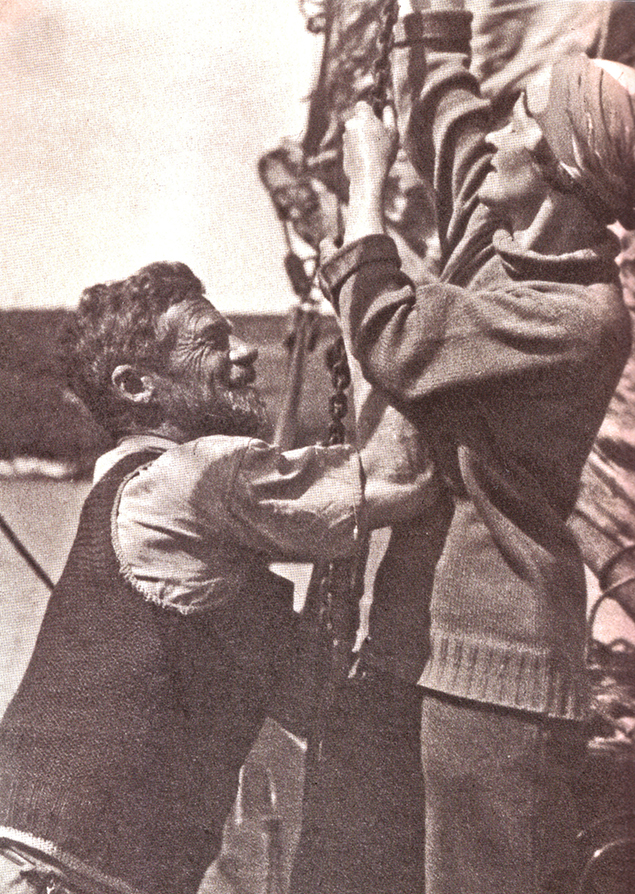 Conor O’Brien and Kitty Clausen O’Brien hoisting sail on Saoirse with a chain halyard. Photo courtesy O’Brien family/Gary MacMahon
Conor O’Brien and Kitty Clausen O’Brien hoisting sail on Saoirse with a chain halyard. Photo courtesy O’Brien family/Gary MacMahon
It was a world O’Brien needed to share with someone special, and miraculously he found that someone with Kitty Clausen. Of an artistic family, she was nevertheless a practical person who was one of the few people who could make Conor O’Brien content, for in his world voyage his impatience with the short-comings of others meant that, in all, Saoirse carried something like 18 different crewmembers before she finally returned to Dun Laoghaire.
Conor and Kitty were married in 1928, and by 1931 a new and mellower Conor O’Brien had emerged as they sailed a slightly more domesticated Saoirse to the Mediterranean. There, they found the then little-known Balearic Island of Ibiza to be a congenial base where Conor continued writing books, and Kitty provided the illustrations. It was an idyllic existence, and their pleasure in it was reinforced by any return visits they made to the Ireland which was emerging after Independence, for they found it an oppressive place far indeed from the idealism of those who, like Conor O’Brien, had actively supported Home Rule.
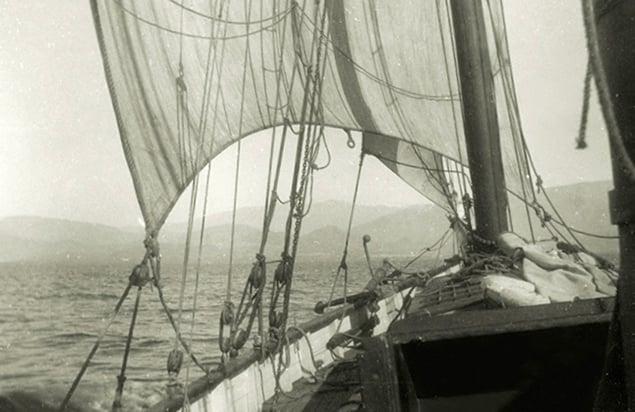 The good times. Aboard Saoirse approaching the Spanish coast during the early 1930s, when Conor and Kitty cruised the Mediterranean. In this photo, Saoirse is setting the mini-brigantine rig which O’Brien created using her existing masts in 1927. Photo courtesy O’Brien family/Gary MacMahon
The good times. Aboard Saoirse approaching the Spanish coast during the early 1930s, when Conor and Kitty cruised the Mediterranean. In this photo, Saoirse is setting the mini-brigantine rig which O’Brien created using her existing masts in 1927. Photo courtesy O’Brien family/Gary MacMahon
 Conor O’Brien as portrayed by Kitty Clausen. Courtesy O’Brien family
Conor O’Brien as portrayed by Kitty Clausen. Courtesy O’Brien family
Thus when they sailed north they tended to go to Falmouth in Cornwall, with their base at St Mawes on the east side of that fine natural harbour. However, cruises to the south continued - they were in the Greek Islands in 1934, and by February 1935 they were wintering in Vigo in northwest Spain. But Kitty’s health was deteriorating, and they returned that summer to St Mawes. She died of leukaemia in 1936, aged 50, and was buried nearby at the waterside church of St Just-in-Roseland.
Conor O’Brien wrote little of her death and what it meant to him, but for some time, his life lost all purpose. He’d lost the urge to cruise Saoirse, and had her hauled in the boatyard across in Falmouth, where he lived a hermit-like existence on board. Then the outbreak of World War II brought him back to life. Like all the gun-runners in 1914, he’d immediately gone into action with the British forces in World War I, serving on mine-sweepers in the North Sea. But on the outbreak of World War II in 1939, with his age now approaching 60 he became involved with the Admiralty Ferry Service, delivering American-built naval and military vessels across the Atlantic.
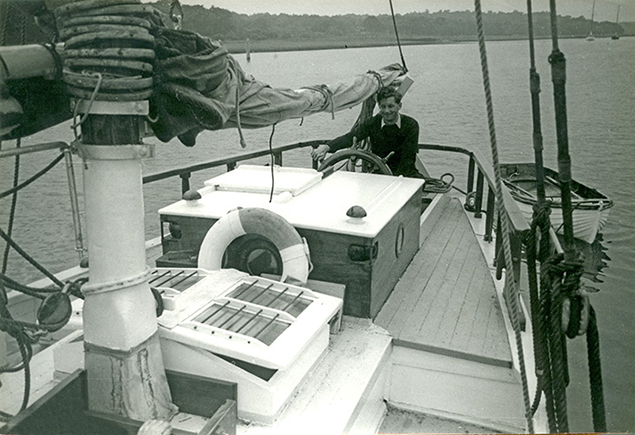 Aboard Saoirse during the Ruck family’s ownership. Photo courtesy O’Brien family/Gary MacMahon
Aboard Saoirse during the Ruck family’s ownership. Photo courtesy O’Brien family/Gary MacMahon
 Saoirse in Dun Laoghaire during a cruise to Iceland in 1974. Photo courtesy O’Brien family/Gary MacMahon
Saoirse in Dun Laoghaire during a cruise to Iceland in 1974. Photo courtesy O’Brien family/Gary MacMahon
While in America, in 1941 he got an offer which he accepted from Eric Ruck to buy Saoirse in Falmouth. Ruck and his family were happily to continue owning this eccentric but very loveable vessel until the late 1960s, following which she had two owners, one of whom brought her to Ireland in the mid-1970s during a voyage to Iceland, while the other then sailed her across the Atlantic and lost her on a Jamaican beach in heavy weather in 1979.
But for Conor O’Brien, from 1945 onwards after the excitement of World War II, life trickled away. He retreated to a cottage on Foynes Island in the Shannon Estuary, and while he joined family on the island for meals, his was a solitary existence, though visits to “nearby Ireland” could occasionally result in unexpected conviviality.
He died in 1952, aged 72, in a world and in an Ireland very different from the high hopes of the 1920s, when a little ketch had set out from Dublin Bay to celebrate the establishment of a newly independent Ireland. In doing so, she was to make one of the greatest voyages of all time, a pioneering achievement which was publicly recognized at the time.
But by the depressed 1930s, people had other things on their mind, and by the 1950s when Conor O’Brien died, it was largely forgotten outside the circles of dedicated cruising enthusiasts.
Yet time heals, and changes our perspective. The voyage of the Saoirse is now more widely acknowledged than ever as an exceptional seafaring achievement, as is the special genius of Conor O’Brien, and the re-creation of Saoirse is the greatest tribute which can be paid to him.
As for the woman who brought him true happiness for a cruelly short time, it was many years ago that we first visited the sailing enthusiast’s church of St Just-in-Roseland on the east side of Falmouth Harbour. But it was only more recently that we learned that Conor O’Brien’s wife is buried there, under a giant pine tree. Her grave is marked by a simple headstone, designed by her husband in his signature style. It is a peaceful place.
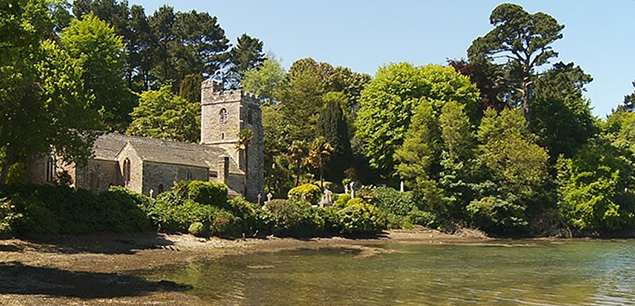 The parish church of St Just-in-Roseland on the eastern shore of Falmouth Harbour. Kitty Clausen O’Brien’s grave is at the foot of the giant pine tree on the right.
The parish church of St Just-in-Roseland on the eastern shore of Falmouth Harbour. Kitty Clausen O’Brien’s grave is at the foot of the giant pine tree on the right.
 The simple headstone, designed by Conor O’Brien. Photo: W M Nixon
The simple headstone, designed by Conor O’Brien. Photo: W M Nixon
Conor O’Brien Ketch Ilen’s Deck to Be Completed By Mid-October
The re-decking of the 57ft Conor O’Brien ketch Ilen (originally built Baltimore 1926) is the latest stage of this major restoration/re-build project to be nearing completion at Liam Hegarty’s boatyard at Oldcourt on the Ilen River between Skibbereen and Baltimore writes W M Nixon. It is expected that the deck will be signed off by October 15th, and work will then proceed on more detailed work.
As part of the project, the new bowsprit – built by trainees in the Ilen Boat-building School in Limerick – was delivered down to Oldcourt last Saturday, and Ilen School Director Gary MacMahon reports a magic moment when Baltimore sailing legend Dermot Kennedy, owner himself of a similar ketch the Richard, called by Oldcourt on Saturday to give the deck his blessing and welcome the bowsprit to West Cork.

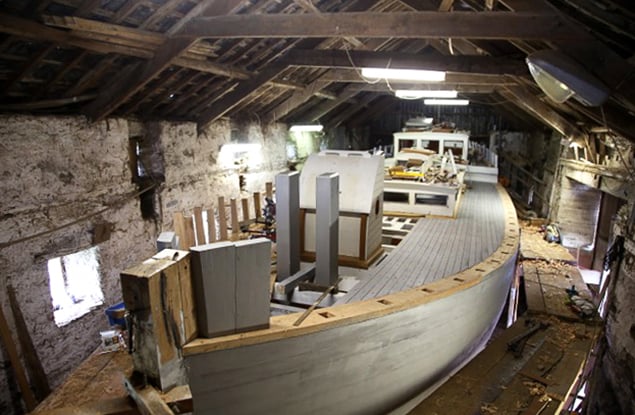 Combined effort. While the hull and deck of the Ilen have been re-constructed in the boatyard at Oldcourt in West Cork, all the deckhouses and hatches have been built in the trainee workshops of the Ilen Boat-Building School in Limerick. Photo: Gary MacMahon
Combined effort. While the hull and deck of the Ilen have been re-constructed in the boatyard at Oldcourt in West Cork, all the deckhouses and hatches have been built in the trainee workshops of the Ilen Boat-Building School in Limerick. Photo: Gary MacMahon
All the deckhouses, hatchways and similar “cabinet” work in the Ilen project has been done in Limerick and then trucked to Oldcourt. There, the main part of the hull and deck re-building has been progressing steadily, sometimes drawing on the talents of international traditional boat-builders who have been enticed to the magnet of West Cork by the quality and scale of the workmanship being produced by Liam Hegarty and his team.
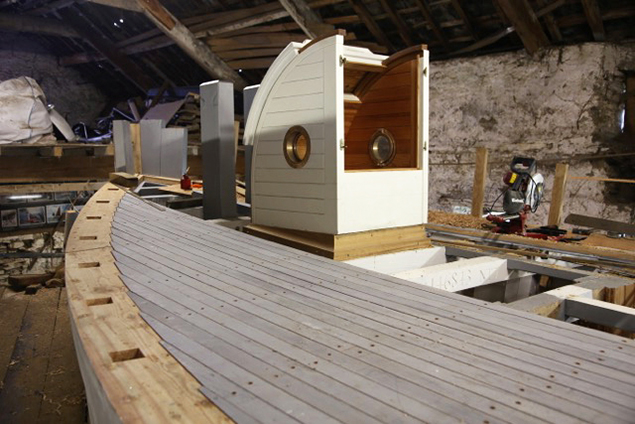 While you wouldn’t expect to find a forehatch like this on a modern offshore racer, on the traditional ketch Ilen the new Limerick-built forehatch housing looks very much at home. Photo: Gary MacMahon
While you wouldn’t expect to find a forehatch like this on a modern offshore racer, on the traditional ketch Ilen the new Limerick-built forehatch housing looks very much at home. Photo: Gary MacMahon
IIen was originally commissioned in 1925 by the Falkland Islanders to be their inter-island communications vessel after they had been properly impressed by her smaller sister, Conor O’Brien’s own-designed 42ft ketch Saoirse, which called to the Falklands in 1925 after rounding Cape Horn during his pioneering global circumnavigation.
O’Brien agreed to be involved with the Ilen project with Tom Moynihan the master shipwright of Baltimore, and then when the vessel was completed, her sailed her out to the Falklands. Because his only qualification was as a yachtmaster, for the delivery voyage the Ilen had to be registered as a yacht for insurance purposes, and she made the voyage under the burgee of the Royal Irish Yacht Club.
 The Ilen on her launching day at Baltimore, 1926. She had to be registered as a yacht for insurance purposes, as her skipper Conor O’Brien’s only qualification was as a yachtsmaster, so he made the delivery to Ilen’s new owners in the Falkland Islands sailing under the burgee of the Royal Irish YC. This also obliged him to carry the RIYC’s then-recognised British blue ensign. But a look at this photo soon reveals the Irish ensign under the bowsprit, celebrating the fact that in making his 1923-25 circumnavigation with Saoirse, Conor O’Brien became the first captain to sail on any major voyage under the Irish tricolour
The Ilen on her launching day at Baltimore, 1926. She had to be registered as a yacht for insurance purposes, as her skipper Conor O’Brien’s only qualification was as a yachtsmaster, so he made the delivery to Ilen’s new owners in the Falkland Islands sailing under the burgee of the Royal Irish YC. This also obliged him to carry the RIYC’s then-recognised British blue ensign. But a look at this photo soon reveals the Irish ensign under the bowsprit, celebrating the fact that in making his 1923-25 circumnavigation with Saoirse, Conor O’Brien became the first captain to sail on any major voyage under the Irish tricolour



























